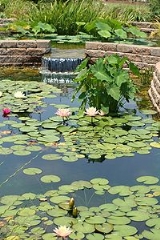
Water garden
Encyclopedia
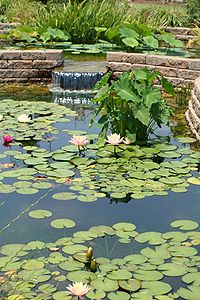
Water feature
In landscape architecture and garden design, a water feature is one or more items from a range of fountains, pools, ponds, cascades, waterfalls, and streams. Before the 18th century they were usually powered by gravity, though the famous Hanging Gardens of Babylon are described by Strabo as...
. A water garden is defined as any interior or exterior landscape or architectural element whose primarily purpose is to house, display, or propagate a particular species or variety of aquatic plant. Although a water garden's primary focus is on plants, they will sometimes also house ornamental fish
Fish
Fish are a paraphyletic group of organisms that consist of all gill-bearing aquatic vertebrate animals that lack limbs with digits. Included in this definition are the living hagfish, lampreys, and cartilaginous and bony fish, as well as various extinct related groups...
, in which case the feature will be a fish pond
Pond
A pond is a body of standing water, either natural or man-made, that is usually smaller than a lake. A wide variety of man-made bodies of water are classified as ponds, including water gardens, water features and koi ponds; all designed for aesthetic ornamentation as landscape or architectural...
.
Although water gardens can be almost any size or depth, they are typically small and relatively shallow, generally less than twenty inches in depth. This is because most aquatic plants are depth sensitive and require a specific water depth in order to thrive. The particular species inhabiting each water garden will ultimately determine the actual surface area and depth required.
Description
When the aquatic flora and fauna is balanced, an aquatic ecosystemAquatic ecosystem
An aquatic ecosystem is an ecosystem in a body of water. Communities of organisms that are dependent on each other and on their environment live in aquatic ecosystems. The two main types of aquatic ecosystems are marine ecosystems and freshwater ecosystems....
is created that supports sustainable
Sustainability
Sustainability is the capacity to endure. For humans, sustainability is the long-term maintenance of well being, which has environmental, economic, and social dimensions, and encompasses the concept of union, an interdependent relationship and mutual responsible position with all living and non...
water quality/water clarity. Elements such as: fountain
Fountain
A fountain is a piece of architecture which pours water into a basin or jets it into the air either to supply drinking water or for decorative or dramatic effect....
s, statuary, waterfall
Waterfall
A waterfall is a place where flowing water rapidly drops in elevation as it flows over a steep region or a cliff.-Formation:Waterfalls are commonly formed when a river is young. At these times the channel is often narrow and deep. When the river courses over resistant bedrock, erosion happens...
s, boulder
Boulder
In geology, a boulder is a rock with grain size of usually no less than 256 mm diameter. While a boulder may be small enough to move or roll manually, others are extremely massive....
s, underwater lighting
Lighting
Lighting or illumination is the deliberate application of light to achieve some practical or aesthetic effect. Lighting includes the use of both artificial light sources such as lamps and light fixtures, as well as natural illumination by capturing daylight...
, lining treatments, edging detailing, in-water and bankside planting and watercourses can be combined with the pool to add visual interest and integration with the local landscape and environment.
History
Water gardens, and all water features in general have been a part of public and private gardens since ancient Persian gardens and Chinese gardenChinese garden
The Chinese garden, also known as a Chinese classical garden, is a style of landscape garden which has evolved for more than three thousand years, and which is inspired by Chinese literature, Chinese painting and Chinese philosophy...
s. Water features have been present and well represented in every era and culture that has included garden
Garden
A garden is a planned space, usually outdoors, set aside for the display, cultivation, and enjoyment of plants and other forms of nature. The garden can incorporate both natural and man-made materials. The most common form today is known as a residential garden, but the term garden has...
s in their landscape and architectural environments. Up until the rise of the industrial age
Industrial Age
Industrial Age may refer to:*Industrialisation*The Industrial Revolution...
, that introduced the modern water pump
Water Pump
Water Pump is one of the neighbourhoods of Gulberg Town in Karachi, Sindh, Pakistan. It is near main Water Pump that supplies fresh water to the city of Karachi....
, water was not recirculated, but was diverted from river
River
A river is a natural watercourse, usually freshwater, flowing towards an ocean, a lake, a sea, or another river. In a few cases, a river simply flows into the ground or dries up completely before reaching another body of water. Small rivers may also be called by several other names, including...
s and spring
Spring (hydrosphere)
A spring—also known as a rising or resurgence—is a component of the hydrosphere. Specifically, it is any natural situation where water flows to the surface of the earth from underground...
s into the water garden, exiting into agricultural fields or natural watercourses. Water features were historically used for plant and fish production for food purposes as well as ornamental aesthetics.
Though a water garden is restricted to a particular type of natural or man-made water feature, used for a relatively specific purpose or intended use, there are many other types of water feature types, styles and designs.
Types of water features
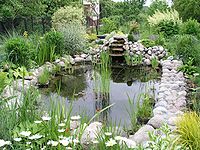
- Natural Water Feature
- Man-made Water Feature
- Naturalistic Water Feature
- Disappearing Water Feature
- Live Water Feature
- Sterile Water Feature
- Water Garden
- Bog Garden
- Rain Garden/Bio Retention System/Rain Harvesting
- Aquatic Container Garden
- Pool/Shallow Pool/Tide Pool
- Reflection Pool/Reflecting PoolReflecting Poolthumb|275px|The Lincoln Memorial Reflecting Pool seen from the [[Washington Monument]] in September 2007.thumb|275px|Ice covering the Lincoln Memorial Reflecting Pool after the [[First North American blizzard of 2010]]....
- Formal Pool
- Swimming Pool
- Pond/Fish Pond/Backyard Pond/Garden Pond
- Naturalistic pond
- Wildlife Pond/Habitat Pond
- Koi PondKoi pondKoi ponds are ponds used for holding koi, usually as part of a landscape. Koi ponds can be designed specifically to promote health and growth of the Nishkigoi or Japanese Ornamental Carp....
- Swimming Pond
- Water Courses
- Brooks
- Creeks
- Streams
- Rivers
- Runnel
- Rile
- Weeping Wall
- Water Wall
- Fountain/Formal Fountain
- Disappearing Fountain
- Tabletop Fountain
- Wall Fountain
- Spitter Fountain
- Bubbler Fountain
- Floating Fountain
- Water Falls
- HydroponicsHydroponicsHydroponics is a method of growing plants using mineral nutrient solutions, in water, without soil. Terrestrial plants may be grown with their roots in the mineral nutrient solution only or in an inert medium, such as perlite, gravel, mineral wool, or coconut husk.Researchers discovered in the 18th...
- LotusLotus (plant)Lotus identifies various plant taxa:* Nelumbo, a genus of aquatic plants with showy flowers** Nelumbo nucifera, the Sacred or Indian lotus** Nelumbo lutea, the American or Yellow lotus...
pool - Rice paddy
- Riparian zone restorationRiparian zone restorationRiparian zone restoration is the ecological restoration of riparian zone habitats of streams, rivers, springs, lakes, floodplains, and other hydrologic ecologies.Riparian zones have been degraded throughout much of the world...
- Wildlife garden - with water-source component.
- Stream poolStream poolA stream pool, in hydrology, is a stretch of a river or stream in which the water depth is above average and the water velocity is quite below average.-Formation:...
- Plunge poolPlunge poolA plunge pool can be a natural hydrologic fluvial landform feature or a constructed recreational garden feature...
- Plunge basin
- Spring (hydrology)
- Seep (hydrology)Seep (hydrology)A Seep is a moist or wet place where water, usually groundwater, reaches the earth's surface from an underground aquifer.-Description:Seeps are usually not of sufficient volume to be flowing beyond their above-ground location. They are part of the limnology-geomorphology system...
- BogBogA bog, quagmire or mire is a wetland that accumulates acidic peat, a deposit of dead plant material—often mosses or, in Arctic climates, lichens....
s - Wetlands
- Mangrove swamp habitatHabitat* Habitat , a place where a species lives and grows*Human habitat, a place where humans live, work or play** Space habitat, a space station intended as a permanent settlement...
- Wild River
- Lakes
- Halka lever
Water follies
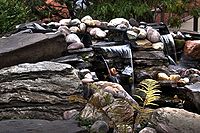
Hero of Alexandria
Hero of Alexandria was an ancient Greek mathematician and engineerEnc. Britannica 2007, "Heron of Alexandria" who was active in his native city of Alexandria, Roman Egypt...
about hydraulics
Hydraulics
Hydraulics is a topic in applied science and engineering dealing with the mechanical properties of liquids. Fluid mechanics provides the theoretical foundation for hydraulics, which focuses on the engineering uses of fluid properties. In fluid power, hydraulics is used for the generation, control,...
and pneumatics
Pneumatics
Pneumatics is a branch of technology, which deals with the study and application of use of pressurized gas to effect mechanical motion.Pneumatic systems are extensively used in industry, where factories are commonly plumbed with compressed air or compressed inert gases...
. His devices, such as temple doors operated by invisible weights or flowing liquids, and mechanical singing birds powered by steam, motivated several European palaces to create similar clever devices to enhance their public image.
In Italy
Italy
Italy , officially the Italian Republic languages]] under the European Charter for Regional or Minority Languages. In each of these, Italy's official name is as follows:;;;;;;;;), is a unitary parliamentary republic in South-Central Europe. To the north it borders France, Switzerland, Austria and...
several royal houses constructed large water gardens incorporating mechanical devices in water settings. The best-known is the Villa d'Este at Tivoli
Tivoli, Italy
Tivoli , the classical Tibur, is an ancient Italian town in Lazio, about 30 km east-north-east of Rome, at the falls of the Aniene river where it issues from the Sabine hills...
, constructed in 1550 AD. A hill cascaded with many fountains and grotto
Grotto
A grotto is any type of natural or artificial cave that is associated with modern, historic or prehistoric use by humans. When it is not an artificial garden feature, a grotto is often a small cave near water and often flooded or liable to flood at high tide...
es,, some with water-driven figures that moved or spouted water. Popularity spread across Europe with the well known water garden at Hellbrunn Palace built, with many water-powered human and animal performing figures and puppet theaters, and folly
Folly
In architecture, a folly is a building constructed primarily for decoration, but either suggesting by its appearance some other purpose, or merely so extravagant that it transcends the normal range of garden ornaments or other class of building to which it belongs...
fountains that erupted without notice to surprise one.
Stream gardens
On a constructed stream, placing rocks in the path of the water makes small patterns, rapids and waterfallWaterfall
A waterfall is a place where flowing water rapidly drops in elevation as it flows over a steep region or a cliff.-Formation:Waterfalls are commonly formed when a river is young. At these times the channel is often narrow and deep. When the river courses over resistant bedrock, erosion happens...
s. The rocks disrupt the waterflow, causing splashing and bubbles to form, which can make pleasant sounds and micro-habitats for plants , fish, and wildlife. Well placed rocks can stimulate splashing water that adds oxygen to prevent hypoxia
Hypoxia (environmental)
Hypoxia, or oxygen depletion, is a phenomenon that occurs in aquatic environments as dissolved oxygen becomes reduced in concentration to a point where it becomes detrimental to aquatic organisms living in the system...
, with the more bubbles - the more dissolved oxygen in the water.
Aquatic flora
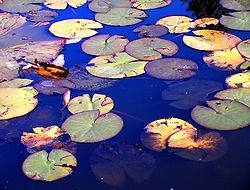
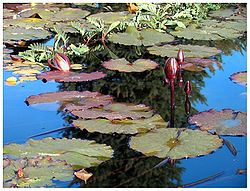
- Submerged plants are those that live almost completely under the water, sometimes with leaves or flowers that grow to the surface such as with the water lily. These plants are placed in a pond or container usually 1–2 ft (0.3048–0.6096 m) below the water surface. Some of these plants are called oxygenators because they create oxygen for the fish that live in a pond. Examples of submerged plants are:
- Water lilyNymphaeaceaeNymphaeaceae is a family of flowering plants. Members of this family are commonly called water lilies and live in freshwater areas in temperate and tropical climates around the world. The family contains eight genera. There are about 70 species of water lilies around the world. The genus...
(Hardy and Tropical) - Hornwort (Ceratophyllum demersumCeratophyllum demersumCeratophyllum demersum is a species of Ceratophyllum. It is a submerged, free-floating aquatic plant, native to North America but nowadays having a cosmopolitan distribution in temperate and tropical regions...
)
- Water lily
- Marginal plants are those that live with their roots under the water but the rest of the plant above the surface. These are usually placed so that the top of the pot is at or barely below the water level. Examples of these are:
- Iris or Flag (IrisIris (plant)Iris is a genus of 260-300species of flowering plants with showy flowers. It takes its name from the Greek word for a rainbow, referring to the wide variety of flower colors found among the many species...
spp.) - Water-crowfoot (Ranunculus fluitansRanunculus fluitansRanunculus fluitans ' is a species of buttercup. It is a perennial and bushy in favourable conditions when it can grow to 6m height...
) - Bulrush (Scirpus lacustris)
- Cattail (Typha latifoliaTypha latifoliaTypha latifolia is a perennial herbaceous plant in the genus Typha. It is found as a native plant species in North and South America, Europe, Eurasia, and Africa...
) - Taro (Colocasia esculentaColocasia esculentaColocasia esculenta is a tropical plant grown primarily for its edible corms, the root vegetables whose many names include Taro and Eddoe. It is believed to be one of the earliest cultivated plants.-Description:Rhizomes of different shapes and sizes...
) - Arrowhead (Sagittaria latifolia)
- Lotus (NelumboNelumboNelumbo is a genus of aquatic plants with large, showy flowers resembling water lilies, commonly known as lotus. The generic name is derived from the Sinhalese word Nelum. There are only two known living species in the genus. The sacred lotus is native to Asia, and is the better known of the two...
spp.) - Pickerelweed (Pontederia cordataPontederia cordataPontederia cordata, commonly known as Pickerelweed, is a monocotyledonous aquatic plant native to North and South America. It can be found on pond and lake margins across an extremely large range from eastern Canada south to Argentina. The species is tristylous, meaning the styles of individual...
)
- Iris or Flag (Iris
- Floating plants are those that are not anchored to the soil at all, but are free-floating on the surface. In water gardening, these are often used as a provider of shade to reduce algae growth in a pond. These are often extremely fast growing/multiplying. Examples of these are:
- Mosquito ferns (Azolla spp.)
- Water-spangle (SalviniaSalviniaSalvinia, a genus in the family Salviniaceae, is a floating fern named in honor of Antonio Maria Salvini, a 17th Century Italian scientist. The genus was published by Séguier, in Pl. Veron. 3: 52. 1754. About ten species exist....
spp.) - Water-clover (MarsileaMarsileaMarsilea is a genus of approximately 65 species of aquatic ferns of the family Marsileaceae.These small plants are of unusual appearance and do not resemble common ferns...
vestita) - Water Lettuce (Pistia stratiotesPistiaPistia is a genus of aquatic plant in the arum family, Araceae. The single species it comprises, Pistia stratiotes, is often called water cabbage, water lettuce, or Nile cabbage. Its native distribution is uncertain, but probably pantropical; it was first described from the Nile near Lake Victoria...
) - Water Hyacinth (Eichhornia crassipesEichhornia crassipesEichhornia crassipes, commonly known as Common Water Hyacinth, is an aquatic plant native to the Amazon basin, and is often considered a highly problematic invasive species outside its native range.-Ecology:...
)
Some areas of the United States do not allow certain of these plants to be sold or kept as they have become invasive species
Invasive species
"Invasive species", or invasive exotics, is a nomenclature term and categorization phrase used for flora and fauna, and for specific restoration-preservation processes in native habitats, with several definitions....
in warmer areas of the country, such as Florida
Florida
Florida is a state in the southeastern United States, located on the nation's Atlantic and Gulf coasts. It is bordered to the west by the Gulf of Mexico, to the north by Alabama and Georgia and to the east by the Atlantic Ocean. With a population of 18,801,310 as measured by the 2010 census, it...
and California
California
California is a state located on the West Coast of the United States. It is by far the most populous U.S. state, and the third-largest by land area...
.
Algae
AlgaeAlgae
Algae are a large and diverse group of simple, typically autotrophic organisms, ranging from unicellular to multicellular forms, such as the giant kelps that grow to 65 meters in length. They are photosynthetic like plants, and "simple" because their tissues are not organized into the many...
are found in all ponds. There are hundreds of species of algae that can grow in garden ponds but they are only usually noticed when they become abundant. Algae often grow in very high densities in ponds because of the high nutrient levels that are typical of garden ponds. Generally alga attaches itself to the sides of the pond and remains innocuous. Some species of algae, namely the dreaded 'blanket weed' can grow up to a foot a day under ideal conditions and can rapidly clog a garden pond. On the other hand, free floating algae are microscopic and are what cause pond water to appear green.
Fish
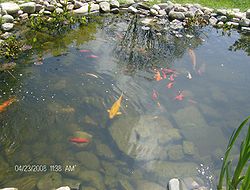
Fish
Fish are a paraphyletic group of organisms that consist of all gill-bearing aquatic vertebrate animals that lack limbs with digits. Included in this definition are the living hagfish, lampreys, and cartilaginous and bony fish, as well as various extinct related groups...
, often koi
Koi
or more specifically , are ornamental varieties of domesticated common carp that are kept for decorative purposes in outdoor koi ponds or water gardens....
, though many people keep goldfish
Goldfish
The goldfish is a freshwater fish in the family Cyprinidae of order Cypriniformes. It was one of the earliest fish to be domesticated, and is one of the most commonly kept aquarium fish....
. Both are hardy, colorful fish which require no special heating, provided the pond is located in an area which does not have extremes of temperature that would affect the fish. If fish are kept, pumps and filtration devices are usually needed in order to keep enough oxygen in the water to support them. In winter, a small heater may need to be used in cold climates to keep the water from freezing solid. Examples of common pond fish include:
- RicefishRicefishThe ricefishes are a family of small ray-finned fish that are found in fresh and brackish waters from India to Japan and out into the Indo-Australian Archipelago, most notably Sulawesi. The common name of the group derives from the fact that many species are found in Japanese rice paddies...
(Himedaka) - MosquitofishMosquitofishThe mosquitofish is a species of freshwater fish, also commonly, if ambiguously, known by its generic name, gambusia. It is sometimes called the western mosquitofish, to distinguish it from the eastern mosquitofish . It is a member of the family Poeciliidae of order Cyprinodontiformes...
- Rosy Red MinnowsFathead minnowThe fathead minnow , is a species of temperate freshwater fish belonging to the Pimephales genus of the cyprinid family. The natural geographic range extends throughout much of North America, from central Canada south along the Rockies to Texas, and east to Virginia and the Northeastern United...
- White Cloud Mountain minnowWhite Cloud Mountain minnowThe White Cloud Mountain minnow is a hardy, species of freshwater fish and coldwater fish often kept in aquaria.These creatures are brilliant for children as they are very easy to look after. The species is a member of the carp family of order Cypriniformes, native to China...
- GoldfishGoldfishThe goldfish is a freshwater fish in the family Cyprinidae of order Cypriniformes. It was one of the earliest fish to be domesticated, and is one of the most commonly kept aquarium fish....
(Common, Comet, Shubunkin varieties, Wakin and the Fantail varieties. With the possible exception of some of the fantail varieties, the fancy goldfish are not suited to pond life.) - Crucian carpCrucian carpThe crucian carp is a member of the family Cyprinidae, which includes many other fish, such as the common carp, or the smaller minnows. They inhabit lakes, ponds, and slow-moving rivers throughout Europe and Asia. The crucian is a medium-sized cyprinid, which rarely exceeds a weight of over 3.3...
- KoiKoior more specifically , are ornamental varieties of domesticated common carp that are kept for decorative purposes in outdoor koi ponds or water gardens....
(Nishikigoi, Butterfly Koi and Ghost Koi) - Mirror carpMirror carpMirror carp are a type of fish, commonly found in the United Kingdom and Europe. The name "Mirror Carp" originates from their scales' resemblance to mirrors. They can grow in excess of 60lb - the last few British record fish have all been mirror carp....
- CarpCarpCarp are various species of oily freshwater fish of the family Cyprinidae, a very large group of fish native to Europe and Asia. The cypriniformes are traditionally grouped with the Characiformes, Siluriformes and Gymnotiformes to create the superorder Ostariophysi, since these groups have certain...
- Weather loachWeather loachThe Dojo Loach , is a freshwater fish in the loach family Cobitidae. They are native to Asia but are also popular as an aquarium fish...
- Golden Orfe
- Golden Tench
- EelEelEels are an order of fish, which consists of four suborders, 20 families, 111 genera and approximately 800 species. Most eels are predators...
- CatfishCatfishCatfishes are a diverse group of ray-finned fish. Named for their prominent barbels, which resemble a cat's whiskers, catfish range in size and behavior from the heaviest and longest, the Mekong giant catfish from Southeast Asia and the second longest, the wels catfish of Eurasia, to detritivores...
- BluegillBluegillThe Bluegill is a species of freshwater fish sometimes referred to as bream, brim, or copper nose. It is a member of the sunfish family Centrarchidae of the order Perciformes.-Range and distribution:...
- Black bassBlack bassMicropterus , is a genus of freshwater fish in the sunfish family of order Perciformes. The type species is M. dolomieu, the smallmouth bass...
- Snakehead
- GobyGobyThe gobies form the family Gobiidae, which is one of the largest families of fish, with more than 2,000 species in more than 200 genera. Most are relatively small, typically less than 10 cm in length...
Snails
- River snail
Small aquatic snail
Snail
Snail is a common name applied to most of the members of the molluscan class Gastropoda that have coiled shells in the adult stage. When the word is used in its most general sense, it includes sea snails, land snails and freshwater snails. The word snail without any qualifier is however more often...
s are usually in ponds which have plants. Some people purchase apple snails to keep in their water garden. Another common variety is the Melantho snail.
Herpetofauna
Ponds located in suburban and rural areas often attract amphibianAmphibian
Amphibians , are a class of vertebrate animals including animals such as toads, frogs, caecilians, and salamanders. They are characterized as non-amniote ectothermic tetrapods...
s such as Common Frog
Common Frog
The Common Frog, Rana temporaria also known as the European Common Frog or European Common Brown Frog is found throughout much of Europe as far north as well north of the Arctic Circle in Scandinavia and as far east as the Urals, except for most of Iberia, southern Italy, and the southern Balkans...
s and Fire Salamander
Fire Salamander
The fire salamander is probably the best-known salamander species in Europe. It is black with yellow spots or stripes to a varying degree; some specimens can be nearly completely black while on others the yellow is dominant. Shades of red and orange may sometimes appear, either replacing or mixing...
s, and reptile
Reptile
Reptiles are members of a class of air-breathing, ectothermic vertebrates which are characterized by laying shelled eggs , and having skin covered in scales and/or scutes. They are tetrapods, either having four limbs or being descended from four-limbed ancestors...
s such as turtle
Turtle
Turtles are reptiles of the order Testudines , characterised by a special bony or cartilaginous shell developed from their ribs that acts as a shield...
s, lizard
Lizard
Lizards are a widespread group of squamate reptiles, with nearly 3800 species, ranging across all continents except Antarctica as well as most oceanic island chains...
s, and snake
Snake
Snakes are elongate, legless, carnivorous reptiles of the suborder Serpentes that can be distinguished from legless lizards by their lack of eyelids and external ears. Like all squamates, snakes are ectothermic, amniote vertebrates covered in overlapping scales...
s.
Predators
Garden ponds can attract attention from predators such as (in North America) raccoonRaccoon
Procyon is a genus of nocturnal mammals, comprising three species commonly known as raccoons, in the family Procyonidae. The most familiar species, the common raccoon , is often known simply as "the" raccoon, as the two other raccoon species in the genus are native only to the tropics and are...
s, Heron
Heron
The herons are long-legged freshwater and coastal birds in the family Ardeidae. There are 64 recognised species in this family. Some are called "egrets" or "bitterns" instead of "heron"....
s, snakes, and domestic cat
Cat
The cat , also known as the domestic cat or housecat to distinguish it from other felids and felines, is a small, usually furry, domesticated, carnivorous mammal that is valued by humans for its companionship and for its ability to hunt vermin and household pests...
s. These predators can be a danger to fish. Owners of koi are often particularly careful to create protected areas as some varieties are very expensive.
See also
- Landscape architectureLandscape architectureLandscape architecture is the design of outdoor and public spaces to achieve environmental, socio-behavioral, or aesthetic outcomes. It involves the systematic investigation of existing social, ecological, and geological conditions and processes in the landscape, and the design of interventions...
- AquascapingAquascapingAquascaping is the craft of arranging aquatic plants, as well as rocks, stones, cavework, or driftwood, in an aesthetically pleasing manner within an aquarium—in effect, gardening under water. Aquascape designs include a number of distinct styles, including the garden-like Dutch style and the...
- Rain gardenRain gardenA rain garden is a planted depression that allows rainwater runoff from impervious urban areas like roofs, driveways, walkways, parking lots, and compacted lawn areas the opportunity to be absorbed...
- Biochemical oxygen demandBiochemical oxygen demandBiochemical oxygen demand or B.O.D. is the amount of dissolved oxygen needed by aerobic biological organisms in a body of water to break down organic material present in a given water sample at certain temperature over a specific time period. The term also refers to a chemical procedure for...
- Chemical oxygen demandChemical oxygen demandIn environmental chemistry, the chemical oxygen demand test is commonly used to indirectly measure the amount of organic compounds in water. Most applications of COD determine the amount of organic pollutants found in surface water or wastewater, making COD a useful measure of water quality...
- Wastewater quality indicatorsWastewater quality indicatorsWastewater quality indicators are laboratory tests to assess suitability of wastewater for disposal or re-use. Tests selected and desired test results vary with the intended use or discharge location. Tests measure physical, chemical, and biological characteristics of the...
- Garden pondGarden pondA garden pond is a water feature constructed in a garden or designed landscape, normally for aesthetic purposes and/or to provide wildlife habitat.-Habitat:...
- Koi pondKoi pondKoi ponds are ponds used for holding koi, usually as part of a landscape. Koi ponds can be designed specifically to promote health and growth of the Nishkigoi or Japanese Ornamental Carp....
- BiotopeBiotopeBiotope is an area of uniform environmental conditions providing a living place for a specific assemblage of plants and animals. Biotope is almost synonymous with the term habitat, but while the subject of a habitat is a species or a population, the subject of a biotope is a biological community.It...

